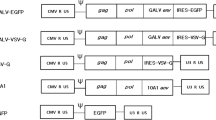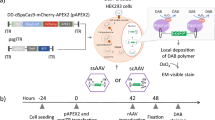Summary
Oncolytic virotherapy is a promising novel form of cancer treatment, but the therapeutic efficiency needs improvement. A potential strategy to enhance the therapeutic effect of oncolytic viruses is to use infectious nucleic acid as therapeutic agent to initiate an oncolytic infection, without administrating infectious viral particles. Here we demonstrate improved viral replication activation efficiency when transfecting cells with 5’ end authentic in vitro transcribed enterovirus RNA as compared to genomic RNA with additional non-genomic 5’ nucleotides generated by conventional cloning methods. We used echovirus 5 (E5) as an oncolytoc model virus due to its ability to replicate in and completely destroy five out of six colon cancer cell lines and kill artificial colon cancer tumors (HT29 spheroids), as shown here. An E5 infectious cDNA clone including a hammerhead ribozyme sequence was used to generate in vitro transcripts with native 5’ genome ends. In HT29 cells, activation of virus replication is approximately 20-fold more efficient for virus genome transcripts with native 5’ genome ends compared to E5 transcripts generated from a standard cDNA clone. This replication advantage remains when viral progeny release starts by cellular lysis 22 h post transfection. Hence, a native 5’ genomic end improves infection activation efficacy of infectious nucleic acid, potentially enhancing its therapeutic effect when used for cancer treatment. The clone design with a hammerhead ribozyme is likely to be applicable to a variety of oncolytic positive sense RNA viruses for the purpose of improving the efficacy of oncolytic virotherapy.



Similar content being viewed by others
References
Jemal A, Bray F, Center MM, Ferlay J, Ward E, Forman D (2011) Global cancer statistics. CA Cancer J Clin 61:69–90. doi:10.3322/caac.20107
Bourke MG, Salwa S, Harrington KJ, Kucharczyk MJ, Forde PF, de Kruijf M, Soden D, Tangney M, Collins JK, O’Sullivan GC (2011) The emerging role of viruses in the treatment of solid tumours. Cancer Treat Rev 37:618–632. doi:10.1016/j.ctrv.2010.12.003
Liu TC, Galanis E, Kirn D (2007) Clinical trial results with oncolytic virotherapy: a century of promise, a decade of progress. Nat Clin Pract Oncol 4:101–117. doi:10.1038/ncponc0736
Russell SJ, Peng KW, Bell JC (2012) Oncolytic virotherapy. Nat Biotechnol 30:658–670. doi:10.1038/nbt.2287
Ochiai H, Campbell SA, Archer GE, Chewning TA, Dragunsky E, Ivanov A, Gromeier M, Sampson JH (2006) Targeted therapy for glioblastoma multiforme neoplastic meningitis with intrathecal delivery of an oncolytic recombinant poliovirus. Clin Cancer Res 12:1349–1354. doi:10.1158/1078-0432.CCR-05-1595
Reddy PS, Burroughs KD, Hales LM, Ganesh S, Jones BH, Idamakanti N, Hay C, Li SS, Skele KL, Vasko AJ, Yang J, Watkins DN, Rudin CM, Hallenbeck PL (2007) Seneca Valley virus, a systemically deliverable oncolytic picornavirus, and the treatment of neuroendocrine cancers. J Natl Cancer Inst 99:1623–1633
Rudin CM, Poirier JT, Senzer NN, Stephenson J Jr, Loesch D, Burroughs KD, Reddy PS, Hann CL, Hallenbeck PL (2011) Phase I clinical study of Seneca Valley Virus (SVV-001), a replication-competent picornavirus, in advanced solid tumors with neuroendocrine features. Clin Cancer Res 17:888–895. doi:10.1158/1078-0432.CCR-10-1706
Shafren DR, Au GG, Nguyen T, Newcombe NG, Haley ES, Beagley L, Johansson ES, Hersey P, Barry RD (2004) Systemic therapy of malignant human melanoma tumors by a common cold-producing enterovirus, coxsackievirus a21. Clin Cancer Res 10:53–60
ClinicalTrials.gov. References within. https://clinicaltrials.gov/ct2/home. Accessed 23 May 2014
Domingo E, Martin V, Perales C, Escarmis C (2008) Coxsackieviruses and quasispecies theory: evolution of enteroviruses. Curr Top Microbiol Immunol 323:3–32
Lauring AS, Andino R (2010) Quasispecies theory and the behavior of RNA viruses. PLoS Pathog 6:e1001005. doi:10.1371/journal.ppat.1001005
Holland J, Spindler K, Horodyski F, Grabau E, Nichol S, VandePol S (1982) Rapid evolution of RNA genomes. Science 215:1577–1585
Working PK, Lin A, Borellini F (2005) Meeting product development challenges in manufacturing clinical grade oncolytic adenoviruses. Oncogene 24:7792–7801. doi:10.1038/sj.onc.1209045
Racaniello VR, Baltimore D (1981) Cloned poliovirus complementary DNA is infectious in mammalian cells. Science 214:916–919
van der Werf S, Bradley J, Wimmer E, Studier FW, Dunn JJ (1986) Synthesis of infectious poliovirus RNA by purified T7 RNA polymerase. Proc Natl Acad Sci U S A 83:2330–2334
Hadac EM, Kelly EJ, Russell SJ (2011) Myeloma xenograft destruction by a nonviral vector delivering oncolytic infectious nucleic acid. Mol Ther 19:1041–1047. doi:10.1038/mt.2011.68
Duke GM, Palmenberg AC (1989) Cloning and synthesis of infectious cardiovirus RNAs containing short, discrete poly(C) tracts. J Virol 63:1822–1826
Klump WM, Bergmann I, Muller BC, Ameis D, Kandolf R (1990) Complete nucleotide sequence of infectious Coxsackievirus B3 cDNA: two initial 5’ uridine residues are regained during plus-strand RNA synthesis. J Virol 64:1573–1583
Herold J, Andino R (2000) Poliovirus requires a precise 5’ end for efficient positive-strand RNA synthesis. J Virol 74:6394–6400
Silvestri LS, Parilla JM, Morasco BJ, Ogram SA, Flanegan JB (2006) Relationship between poliovirus negative-strand RNA synthesis and the length of the 3’ poly(A) tail. Virology 345:509–519. doi:10.1016/j.virol.2005.10.019
Lazouskaya NV, Palombo EA, Poh CL, Barton PA (2014) Construction of an infectious cDNA clone of Enterovirus 71: insights into the factors ensuring experimental success. J Virol Methods 197:67–76. doi:10.1016/j.jviromet.2013.12.005
Friedrich J, Ebner R, Kunz-Schughart LA (2007) Experimental anti-tumor therapy in 3-D: spheroids-old hat or new challenge? Int J Radiat Biol 83:849–871. doi:10.1080/09553000701727531
Israelsson S, Jonsson N, Gullberg M, Lindberg AM (2011) Cytolytic replication of echoviruses in colon cancer cell lines. Virol J 8:473. doi:10.1186/1743-422X-8-473
Israelsson S, Gullberg M, Jonsson N, Roivainen M, Edman K, Lindberg AM (2010) Studies of Echovirus 5 interactions with the cell surface: heparan sulfate mediates attachment to the host cell. Virus Res 151:170–176. doi:10.1016/j.virusres.2010.05.001
Lindberg AM, Polacek C, Johansson S (1997) Amplification and cloning of complete enterovirus genomes by long distance PCR. J Virol Methods 65:191–199
Lindberg AM, Johansson S, Andersson A (1999) Echovirus 5: infectious transcripts and complete nucleotide sequence from uncloned cDNA. Virus Res 59:75–87
Lindberg AM, Andersson A (1999) Purification of full-length enterovirus cDNA by solid phase hybridization capture facilitates amplification of complete genomes. J Virol Methods 77:131–137
Hierholzer JC, Killington RA (1996) Virus isolation and quantitation. In: Mahy BWJ, Kangro HO (eds) Virology methods manual. Academic Pres Limited, Glasgow, pp 25–46
Jonsson N, Gullberg M, Lindberg AM (2009) Real-time polymerase chain reaction as a rapid and efficient alternative to estimation of picornavirus titers by tissue culture infectious dose 50 % or plaque forming units. Microbiol Immunol 53:149–154. doi:10.1111/j.1348-0421.2009.00107.x
Willems E, Leyns L, Vandesompele J (2008) Standardization of real-time PCR gene expression data from independent biological replicates. Anal Biochem 379:127–129. doi:10.1016/j.ab.2008.04.036
Khetsuriani N, Lamonte-Fowlkes A, Oberst S, Pallansch MA (2006) Enterovirus surveillance-United States, 1970–2005. MMWR Surveill Summ 55:1–20
Roos FC, Roberts AM, Hwang II, Moriyama EH, Evans AJ, Sybingco S, Watson IR, Carneiro LA, Gedye C, Girardin SE, Ailles LE, Jewett MA, Milosevic M, Wilson BC, Bell JC, Der SD, Ohh M (2010) Oncolytic targeting of renal cell carcinoma via encephalomyocarditis virus. EMBO Mol Med 2:275–288. doi:10.1002/emmm.201000081
Shafren DR, Sylvester D, Johansson ES, Campbell IG, Barry RD (2005) Oncolysis of human ovarian cancers by echovirus type 1. Int J Cancer 115:320–328
Atkins GJ, Smyth JW, Fleeton MN, Galbraith SE, Sheahan BJ (2004) Alphaviruses and their derived vectors as anti-tumor agents. Curr Cancer Drug Targets 4:597–607
Pfeiffer JK, Kirkegaard K (2003) A single mutation in poliovirus RNA-dependent RNA polymerase confers resistance to mutagenic nucleotide analogs via increased fidelity. Proc Natl Acad Sci U S A 100:7289–7294. doi:10.1073/pnas.1232294100
Vignuzzi M, Wendt E, Andino R (2008) Engineering attenuated virus vaccines by controlling replication fidelity. Nat Med 14:154–161. doi:10.1038/nm1726
Acknowledgements
We thank Christina Gustafson-Svärd and Hans-Christoph Selinka for providing cells. This study was supported by grants from the National Graduate School of Pharmaceutical Sciences (FLäK) and the Faculty of Health and Life Science, Linnaeus University.
Conflict of interests
The authors declare that they have no conflict of interests.
Author information
Authors and Affiliations
Corresponding author
Rights and permissions
About this article
Cite this article
Israelsson, S., Sävneby, A., Ekström, JO. et al. Improved replication efficiency of echovirus 5 after transfection of colon cancer cells using an authentic 5’ RNA genome end methodology. Invest New Drugs 32, 1063–1070 (2014). https://doi.org/10.1007/s10637-014-0136-z
Received:
Accepted:
Published:
Issue Date:
DOI: https://doi.org/10.1007/s10637-014-0136-z




